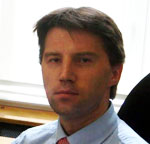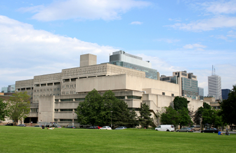Participez à la conversation!
... et contribuez à la valorisation de la MF
« It was the combination of the ability to see a broader population and diseases that attracted me to family medicine. »
An Interview with Dr. Karl Iglar
Family Medicine Residency Program Director of the University of Toronto

While doing an elective at the University of Toronto, I had the pleasure of meeting
Dr. Karl Iglar, current director of the postgraduate family medicine program at the University of Toronto. We chatted about his own path onto family medicine, CaRMS 101, and the myths of family medicine.
L.M. To start off, what brought you into family medicine yourself?
K.I. This is going back a few years. While I was going through various clinical rotations in medical school, I couldn’t find one that I necessarily preferred more than the other. Originally I was thinking about internal medicine, but I would have missed the interaction with children, for example. It was the combination of the ability to see a broader population and diseases that attracted me to family medicine.
L.M. What does your job involve now on a daily basis?
K.I. My job is essentially 50% administration, and 50% clinical medicine and teaching. I have an inner-city practice at St. Michael’s Hospital in Toronto, where my patient population is fairly diverse but skewed more towards geriatrics. I also teach the Arts and Science of Clinical Medicine and Evidence-based Medicine in the undergraduate and postgraduate curricula, respectively.
The other 50% is administrative. As postgraduate program director of family medicine, I am responsible for the largest program in the country, where by July of next year we will have about 170 first year PGY 1 trainees and more than 350 residents in total.
L.M. As the largest family medicine program in the country, how competitive is it to get in?
K.I. It’s fairly competitive relative to other programs in the country. It’s been a number of years since we have not filled the Greater Toronto Area program in the first iteration. Generally we choose 170 candidates from a pool of 500-600 applicants.
L.M. In your own words, what are the main strengths of the program?
K.I. The program is very flexible. Our residents can choose from a number of training sites, from tertiary care centers or community hospitals. Just over half of the family medicine sites have a horizontal program where, instead of family medicine blocks, our residents spend 3 half-days per week in a family medicine clinic to allow them to provide more optimal continuity of care for their patients. Our PGY 3 programs are very extensive. The emergency PGY3 program is one of the most competitive in the country.
We have excellent faculty and site directors and attract the best and brightest residents that are interested in family medicine. We also have significant resident involvement in the program whereby resident representatives sit on our program committee and have significant input in how the program is run.
L.M. With these many attractions, let’s talk about the application process. What do you consider are the most important documents in a submitted CaRMS application?
K.I. Two things really. What we’re looking for is an excellent academic record and an interest in family medicine. How can students convey their interest? They can do that through a strong personal letter, and secondarily through their reference letters. They should show that they’ve had experiences in family medicine, either through an elective in family medicine or a reference letter from a family doctor. Those are really the two elements that we feel are the strongest in assessing a candidate.
For the recommendation letters, how important is it to have letters from several family physicians?
Quality is more important than quantity. An excellent letter from a family physician who feels you’ll make a great family doctor upon completion of training is probably more important than having 3 letters that are good but not stellar.
L.M. What about the need of a letter from a physician associated with the University of Toronto?
K.I. To be honest with you, it doesn’t really matter. Because of the number of people who will be applying to our program, we can’t accommodate all the students to do an elective with us. However, it’s very important to show interest in family medicine. One way to do that is to do an elective, be it in a rural or urban area, in Ontario or elsewhere.
L.M. Finally, for those contemplating a career in family medicine: there are prejudices in every specialty, and family medicine is no exception. What do you think these prejudices are and what would be your response to them?
K.I. One of the major prejudices is prestige. For a lot of medical students, especially coming from universities where the percentage of students going into family medicine is lower, they may think that being a family doctor is less noble than a subspecialist. What is my response to that? What you have to look at is the fit. If being a family doctor excites you, then you can overcome those feelings or notions from other people.
The other portrayed disadvantage, linked to prestige, is financial compensation. That is becoming less of an issue with the emergence of family health teams. Working as a group of physicians, you look after more patients, are provided with additional support from other healthcare professionals, and you’re compensated in a more equitable way. We’ve seen a shift in the number of applications to our program because of some of these changes.
You have a major decision to make early on in your training. You may not be 100% sure about the decision, but as you practice over time, you will feel more comfortable and discover that family medicine is an excellent career.
Dans ce numéro
- À propos de nous
- Éditorial
- Espace FMOQ
- Espace CQMF
- Espace FMRQ
- Les variétés de pratique
Le GIMT
La pédiatrie
La petite chirurgie - Stage coup de coeurHôpital de Chisasibi
- 3 UMF en vedette
Estrie
Rimouski
Sacré-Coeur - Médecin de famille vedette
- Étudiant vedette
- Collaborations spéciales
- Chronique techno
- GIMF
- Santé mentale
Le FaMSIG
Même si l’hiver approche, l’enthousiasme au sein de FaMSIG est loin de se refroidir! Plusieurs médecins attendent avec impatience l’occasion de partager leur passion avec vous. Voici un aperçu de leurs intérêts : recherche, médecine familiale rurale, gériatrie, obstétrique, soins aux réfugiés. Étudiants de McGill, restez à l’affût, les détails seront disponibles prochainement. +
Départements de médecine familiale
Les départements de médecine familiale soutiennent les GIMF financièrement et logistiquement dans l’organisation de leurs activités annuelles. Pour tout connaître sur leurs programmes et UMF, cliquez sur leur nom.
University of TO

University of Toronto Medical School Building. The two buildings in the immediate background are its associated hospitals and research institutes.